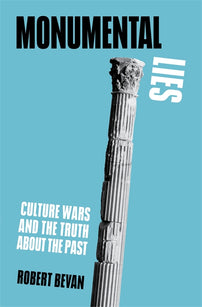The past cannot be denied, nor can it be allowed to stand without criticism.
“The Culture Wars cannot be seen on their own–they are part of something bigger, and more dangerous.” A letter from the editor of Robert Bevan’s Monumental Lies.

Leo Hollis is the editor of Monumental Lies: Culture Wars and the Truth about the Past by Robert Bevan. See all our fall book club selections!
I sometimes wonder, do the Culture Wars actually exist? It is easy to assume that they are conjured by a divisive media or the rhetorical flourish from politicians who have little to give. Robert Bevan argues that they are real but often so close that they are sometimes difficult to discern.
The battleground is beneath your feet. It is being waged in the once-public spaces that have now been privatised. It is in the fabric of the historical buildings around us - on what we call heritage or what we just call old and ugly. As well as what we are allowed to put up in its place. What is clear is that Culture Wars cannot be seen on their own- they are part of something bigger, and more dangerous. And that is where Monumental Lies comes in.
Consider the question of what is beautiful. Is it so subjective? Is it a political question? In the UK the conservative government were so concerned by this that they set up a commission led by the reactionary philosopher, Sir Roger Scruton to work out what we should appreciate and what we should discard. In countries such as Austria and Switzerland there have been debates over whether a minaret is an ‘appropriate’ addition to their historic skyline.
It also forces us to ask: How should we treat the historic material of the past - especially a past we no longer are proud of or agree with? Can a former icon of fascist architecture comfortably become the flagship store of high fashion? In India, Hindu nationalists claim that there is no Islamic heritage worthy of the name. In Australia, how to restore aboriginal sites of importance when they have been systematically destroyed over centuries? Heritage has never been more alive, nor more dangerous.
I first came across Robert Bevan’s writing as the London Evening Standard’s architecture correspondent, where weekly he would bring some sense to the capital’s latest edifical madness. He was always clear about what he thought, and often pointed out that the city was often as gullible and poorly dressed as the naked emperor. His first book, The Architecture of Destruction, was something else, however. It unpacked the crucial subject of cultural genocide: how the destruction of ancient artifacts, statues and sites of cultural significance was a new tactic in the 21st-century conflict. Take 9/11 as an obvious example. What was the symbolic value of the Twin Towers? Watching the Taliban deface the Buddhas of Bamiyan or ISIS’s taking a hammer to the columns of Palmyra, one was observing war by other means.
What he shows in Monumental Lies is that these same questions are now being played out closer to home, and by our own politicians, cultural critics and practitioners. There are plenty of hand grenades in this book to lob at the opposition, but there are also plenty of complicated layered questions that we need to ask ourselves too. The obvious example of this is whether to take down public statues of historic figures we now abhor. What should be done? The answer is not simple, and we should think about ways that respect the past while also educating the present: the past cannot be denied nor can it be allowed to stand without criticism.
Should we approve of how the statue of Colston in Bristol that was pulled down and rolled into the waters of the docks, now lies battered in a museum with a description of the event for all to see? Or the statue of the dictator Alfredo Stroessner in Asuncion, Paraguay, that was broken into pieces and then reconstituted into a new statue symbolising his defeat. In the book, Bevan returns to one monument, in particular: a fascist frieze created in the Italian town of Bolzano and left to stand long after Mussolini was hung from a lamppost. In the 1990s it was decided by a group of locals to refashion the space with a neon sign running across the frieze’s frontage spelling out a quote from Hannah Arendt: No One has the Right to Obey.
Monumental Lies is a serious contribution to a debate that runs across all aspects of our cultural lives and politics. From what to display in museums to how we restore structures that have been destroyed in war. It gets to the heart of how architecture and planning can be used to decide the deeply political questions about who is allowed into the city, and who isn’t. It forces us to reckon with the fabric of the past and consider what we are doing as we build the future. And Robert Bevan is a deeply knowledgeable guide and mentor, who draws on a global set of examples to illustrate his engaging and accessible argument.
These questions are focused on what to do with stone and public space - the very places where we live our everyday lives. However, there is a deeper debate here, far beyond statues and whether UNESCO should preserve one historic place, as if in aspic, or not. It gets to who we are, and what makes us this way. How our surroundings influence what we are to become, can raise our horizons or condemn us to limited expectations. Bevan shows us that we should demand more from the world we build around us.
– Leo Hollis,
London, UK, September 2022
